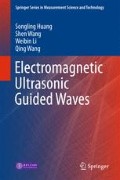Abstract
There are two principles of the thickness measurement by electromagnetic ultrasonics: One is based on Lorentz force, which is suitable for conductor materials, and the other is based on magnetostrictive force, which is suitable for ferromagnetic conductive materials. In the process of thickness measurement, the ferromagnetic conductive materials will be affected by two different forces.
Access this chapter
Tax calculation will be finalised at checkout
Purchases are for personal use only
References
Xin, J.: Development of electromagnetic ultrasonic thickness measurement device. Tsinghua University, Beijing (2009). (In Chinese)
Li, P., Huang, S., Wang, S., et al.: Development of a pulsed exciting source for electromagnetic ultrasonic detection. Electr Measur & Instrum 49(2), 76–79 (2012). (In Chinese)
Wang, S., Huang, S., Zhao, W.: Virtual instrument technology of electromagnetic ultrasonic data acquisition and analysis software design. Instrum Tech Sens 315(5), 37–39 (2009). (In Chinese)
Zhang, Y., Huang, S., Zhao, W.: Development of the high frequency pulsed electrical source. Power Electron 42(7), 49–50 (2008). (In Chinese)
Huang, S., Ye, C., Wang, S., et al.: Design of electromagnetic ultrasonic detector for the crack detection in natural gas pipe. Nondestr Test 31(10), 827–829 (2009). (In Chinese)
Huang, S., Wang, S., Zhao, W., et al.: Study on oil and gas pipeline crack detection method based on EMAT-generated ultrasonic guided waves. In: The 3rd World Conference on Safety of Oil and Gas Industry (WCOGI 2010), pp. 491–493 (2010)
Huang, S., Wang, S., Zhao, W.: Study on oil and gas pipeline crack detection method based on EMAT-generated ultrasonic guided waves. Measur. Technol. 23(S), 34–36 (2009) (In Chinese)
Author information
Authors and Affiliations
Corresponding author
Rights and permissions
Copyright information
© 2016 Tsinghua University Press and Springer Science+Business Media Singapore
About this chapter
Cite this chapter
Huang, S., Wang, S., Li, W., Wang, Q. (2016). Applications of the Electromagnetic Ultrasonic Guided Wave Technique. In: Electromagnetic Ultrasonic Guided Waves. Springer Series in Measurement Science and Technology. Springer, Singapore. https://doi.org/10.1007/978-981-10-0564-0_7
Download citation
DOI: https://doi.org/10.1007/978-981-10-0564-0_7
Published:
Publisher Name: Springer, Singapore
Print ISBN: 978-981-10-0562-6
Online ISBN: 978-981-10-0564-0
eBook Packages: Physics and AstronomyPhysics and Astronomy (R0)

